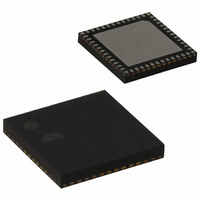EM357-RTR Ember, EM357-RTR Datasheet - Page 148

EM357-RTR
Manufacturer Part Number
EM357-RTR
Description
IC RF TXRX ZIGBEE 192KB 48QFN
Manufacturer
Ember
Specifications of EM357-RTR
Frequency
2.4GHz
Data Rate - Maximum
250kbps
Modulation Or Protocol
802.15.4 Zigbee
Applications
General Purpose
Power - Output
5dBm
Sensitivity
-100dBm
Voltage - Supply
2.1 V ~ 3.6 V
Current - Receiving
26mA
Current - Transmitting
31mA
Data Interface
PCB, Surface Mount
Memory Size
192kB Flash, 12kB RAM
Antenna Connector
PCB, Surface Mount
Operating Temperature
-40°C ~ 85°C
Package / Case
48-QFN
Lead Free Status / RoHS Status
Lead free / RoHS Compliant
Other names
636-1011-2
Available stocks
Company
Part Number
Manufacturer
Quantity
Price
Company:
Part Number:
EM357-RTR
Manufacturer:
SILICON
Quantity:
3 000
Part Number:
EM357-RTR
Manufacturer:
SILICON
Quantity:
20 000
- Current page: 148 of 245
- Download datasheet (12Mb)
9.3.13.3
In trigger mode the counter starts in response to an event on a selected input.
In the following example, the up-counter starts in response to a rising edge on the TI2 input:
When a rising edge occurs on TI2, the counter starts counting on the internal clock and the INT_TIMTIF flag is
set. The delay between the rising edge on TI2 and the actual start of the counter is due to the
resynchronization circuit on the TI2 input.
Figure 9-29 illustrates the example in which the counter is started by a rising edge on TI2.
9.3.13.4
External clock mode 2 can be used in combination with another slave mode (except external clock mode 1 and
encoder mode). In this case, the ETR signal is used as external clock input, and another input can be selected
as trigger input when operating in reset mode, gated mode or trigger mode. It is not recommended to select
ETR as TRGI through the TIM_TS bits of TIMx_SMCR register.
In the following example, shown in Figure 9-30, the up-counter is incremented at each rising edge of the ETR
signal as soon as a rising edge of TI1 occurs:
Configure channel 2 to detect rising edges on TI2:
Configure the timer in trigger mode: Write TIM_SMS = 110 in the TIMx_SMCR register.
Select TI2 as the input source by writing TIM_TS = 110 in the TIMx_SMCR register.
Configure the external trigger input circuit: Program the TIMx_SMCR register as follows:
Configure the channel 1 to detect rising edges on TI, as follows:
Configure the timer in trigger mode: WriteTIM_SMS = 110 in the TIMx_SMCR register.
Select TI1 as the input source by writing TIM_TS = 101 in the TIMx_SMCR register.
•
•
•
•
•
•
•
•
•
•
•
Slave Mode: Trigger Mode
Slave Mode: External Clock Mode 2 +Trigger Mode
Configure the input filter duration. In this example, no filter is required so TIM_IC2F = 0000.
The capture prescaler is not used for triggering, so it is not configured.
The TIM_CC2S bits select the input capture source only, TIM_CC2S = 01 in the TIMx_CCMR1 register.
Write TIM_CC2P = 0 in the TIMx_CCER register to validate the polarity and detect high level only.
TIM_ETF = 0000: no filter.
TIM_ETPS = 00: prescaler disabled.
TIM_ETP = 0: detection of rising edges on ETR and TIM_ECE = 1 to enable the external clock
mode 2.
TIM_IC1F = 0000: no filter.
The capture prescaler is not used for triggering and does not need to be configured.
TIM_CC1S = 01 in the TIMx_CCMR1 register to select only the input capture source.
TIM_CC1P = 0 in the TIMx_CCER register to validate the polarity (and detect rising edge only).
Figure 9-29. Control Circuit in Trigger Mode
Final
9-24
120-035X-000G
Related parts for EM357-RTR
Image
Part Number
Description
Manufacturer
Datasheet
Request
R

Part Number:
Description:
MODULE EM357 PA/LNA W/ANT TG
Manufacturer:
Ember
Datasheet:

Part Number:
Description:
MODULE EM357 NO PA/LNA W/ANT TG
Manufacturer:
Ember
Datasheet:

Part Number:
Description:
MODULE EM357 NO PA/LNA W/RF CONN
Manufacturer:
Ember
Datasheet:

Part Number:
Description:
MODULE EM357 PA/LNA W/RF CONN
Manufacturer:
Ember
Datasheet:

Part Number:
Description:
IC RF TXRX ZIGBEE 192KB 48QFN
Manufacturer:
Ember
Datasheet:

Part Number:
Description:
KIT DEV EMBER ZIGBEE W/PCWH
Manufacturer:
Custom Computer Services Inc (CCS)

Part Number:
Description:
PROGRAMMER USB FLASH EM250/260
Manufacturer:
Ember
Datasheet:

Part Number:
Description:
IC ZIGBEE SYSTEM-ON-CHIP 40-QFN
Manufacturer:
Ember
Datasheet:

Part Number:
Description:
IC ZIGBEE SYSTEM-ON-CHIP 48-QFN
Manufacturer:
Ember
Datasheet:

Part Number:
Description:
IC RF TXRX ZIGBEE 128KB 48QFN
Manufacturer:
Ember
Datasheet:

Part Number:
Description:
INSIGHT ADAPTER FOR EM2XX
Manufacturer:
Ember
Datasheet:

Part Number:
Description:
PROGRAMMER USB FLASH EM250/260
Manufacturer:
Ember
Datasheet:

Part Number:
Description:
IC ZIGBEE SYSTEM-ON-CHIP 40-QFN
Manufacturer:
Ember
Datasheet:

Part Number:
Description:
IC ZIGBEE SYSTEM-ON-CHIP 48-QFN
Manufacturer:
Ember
Datasheet:

Part Number:
Description:
IC RF TXRX ZIGBEE 128KB 48QFN
Manufacturer:
Ember
Datasheet:











